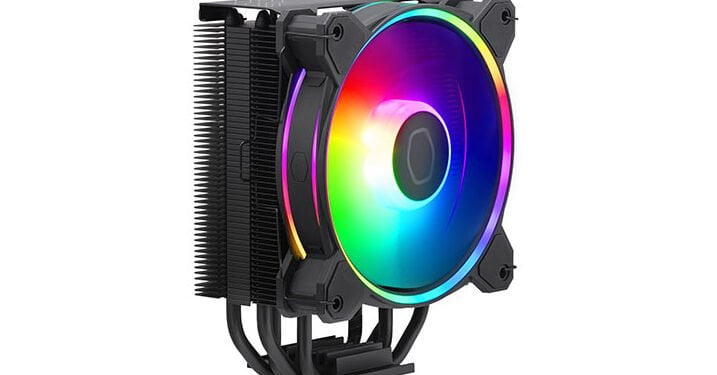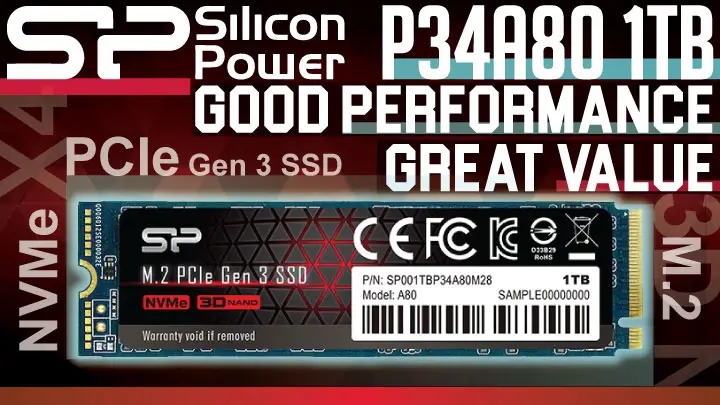
As we have said in the past Cooler Master pride themselves on having shipping containers that easily standout from the crowd. To us, it may be a (very) little thing but the effort a company puts into a product’s box, a box most throw away, can provide a lot of insight into a company and their ‘culture’. To us, this box makes it obvious that Cooler Master’s design team not only take pride in their work but love what they do. Put bluntly this is an above average shipping container… and is even above average for its above average asking price (by the standards of value orientated corner of the market). It does make a great first impression and does help justify the moderate increase in price from the last generation “RGB Black Edition”.
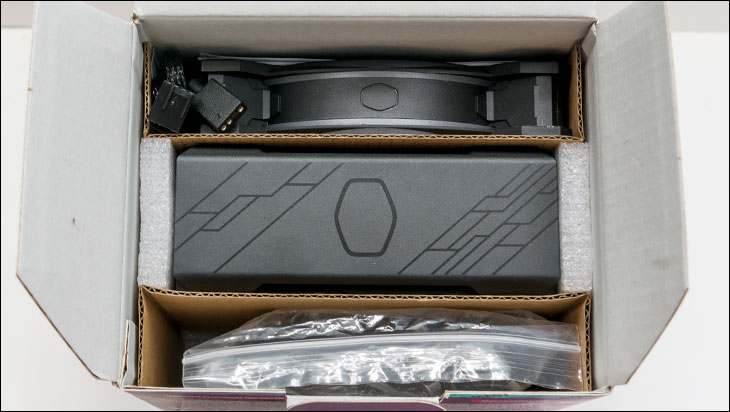
We say all that, because the Halo Black (as we are going to call it for brevity’s sake) shipping container is not just a pretty face. Yes, the outside is covered in pictures of the Halo Black. Yes, it has all the data anyone, even a novice, requires to help make an informed decision. However, that is all ‘skin deep’ data points. Instead, it is the internals of this box that help set it apart from the chineseium clones that have run rampant on CM’s bottom line for the past couple years. Unlike many, including other premium companies, the Halo Black uses a defense in depth strategy. Yes, separating the fan, the accessories, and the actual cooler from each other is not unique. Yes, other $50’ish cooler do something similar. However, it is a fairly easy way to separate the ‘good ones’ from the rest of the pack… and Cooler Master is certainly in the former and not the latter category.
Moving on.

Compared to the circa 2019 RGB Black Edition (even with the 1700 upgrade kit)… the Cooler Master Hyper 212 Halo Black’s accessories are noticeably improved. Put simply, where the last gen mostly just used slightly refreshed variants of the same hardware the original Hyper 212 shipped with, and those that were upgraded were arguably downgrades, Cooler Master has upgraded the hardware for the Halo Black. Gone is the bent/curved mounting brackets. Gone is the dumb as a box of rocks plastic fan brackets that the RGB Black came with. Gone is the “we really don’t get RGB” RGB fan. In their stead we get actually good mounting hardware. Brackets that are much easier to install… albeit it still relies on a small screw to mount them the Halo Black.

We get actually good wire brackets to mount the fan(s) to the cooling tower. Sadly, we only get two (i.e. enough to mount one fan) not four. Of course, unlike plastic brackets, wire brackets are not exactly hard to source or even make.

Even gone is the fan that just used see through plastic for the fan blade+hub to give it RGB. Instead we get a very decent fan that not only offers glowing fan blades (and hub) but has two ring light diffusers baked right into the fan’s chassis. Mix in the RGB abilities are auto-sensing (so as to be motherboard manufacture agnostic) with the fact that while the fan bearings have not been upgraded (still mid-grade ‘rifle’ and not Fluid Dynamic or MagLev based), and the speeds have not (~2k)… the new fan blades are better. Going from a 9 to a 7-blade configuration may not show much static pressure improvements / change on paper but in reality these larger and more robust fan blades can push air more effectively at lower RPMS than the 9-bladed predecessor. In turn it can cool better at lower RPMs and thus make less noise than any 212 before it could. So much so, this would be the first 212 that we would not just trash the included fan and replace with an Arctic P12! Color us impressed.
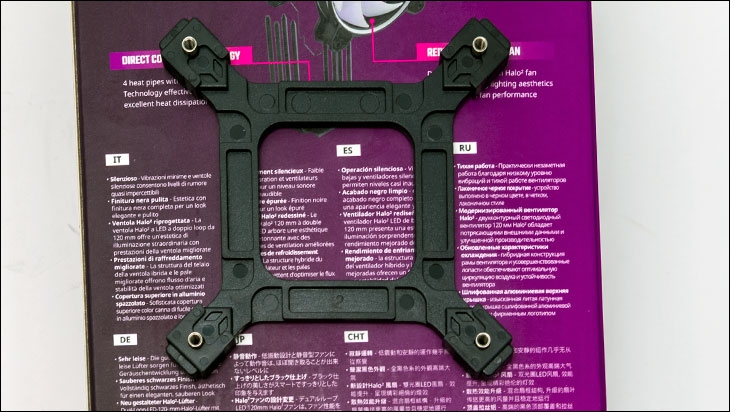
Also gone is the useless “you must first build the backplate” style that some of the clones still use, and instead the posts and securing caps come pre-applied to the backplate for you. All one need do is slide them in or out depending on the Intel socket type you plan on using.

Overall, these improvements represent a massive upgrade over the last gen Hyper 212. Enough that it more than justifies the minor increase in asking price. The accessories are however not the only things than have been improved… as the Halo Black (and Halo White) is not just a Hyper 212 RGB B.E. hunter/killer. It was designed to hunt down the Chinese 212 clones and terminate them faster (and harder) than what the last Terminator “movie” did to the entire Terminator franchise. That is a dramatically tougher hunt… especially if one was to trash the stock fan and use an aftermarket one like many an experienced system builder did with both clone and OG alike.
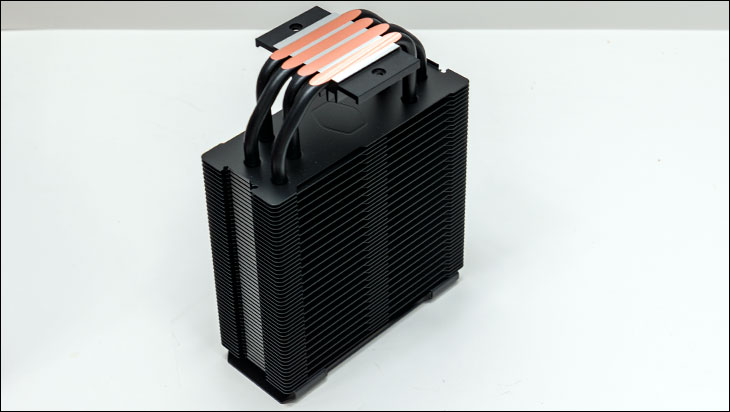
After all, the clones are not only cheaper but are rather decent… as they out and out copied the 212 design. A four 6mm heatpipe ‘Direct Touch’ (or what Cooler Master calls ‘Direct Contact’) base is a four 6mm heatpipe ‘Direct Touch’ base. Sadly, the Halo Black still uses a base that does not offer full LGA 1700 (or AM5) IHS coverage. Instead, it basically is the same size as what the RGB Black Edition and clones use. Yes, an increase in size would have meant fully retooling the Hyper 212 manufacturing line. Possibly even requiring an extra (two) heat pipe(s) be added to the mix… but this is a base that can trace its roots (almost) directly back to LGA 1156 days. Back then the very idea of a 24 core processor in the consumer market place was not a pipe dream. It was absurd. No ‘sane’ CPU cooling engineer would have tried and build a cooler for that. They built them around the idea of cooling a monolithic four core CPU. That sat smack dab in the middle of its IHS. As such this lack of full IHS coverage makes the Halo Black’s intended job a touch more difficult that it need/should be.

The same is true of the overall dimensions of the cooling tower. With overall dimensions of 124x154x77mm the amount of surface area in the fin array to cool those four heatpipes is a tad limited. This is the same issue that Noctua’s “Slim” line suffers from… but Noctua may the rational decision to offer both a 120mm and a 140mm sized array. Such a change would not have impacted the sterling reputation the Hyper 212 series has for playing nice with even oversized RAM (and VRM heatsinks). All it would have done is traded a minor amount of motherboard incompatibility (i.e. motherboards with oversized VRM heatsinks) for noticeably improved cooling performance. They did not, and once again an easily solvable issue makes the 212 Halo Black’s task more difficult that it arguably should have been.
That however is the sum total of missteps Cooler Master has made with the new addition to the 212 line-up.

Let’s start with the base. Counteracting the clone version(s) of the exact same design… Cooler Master spends more time, effort, and care in finishing the base. With HDT/DC bases polishing to a mirror shine is basically impossible compared nickel plated ‘solid’ base designs. Copper heatpipes by their very nature are thin walled tubes of soft copper and the more you grind away to make the base smoother… the higher the risks of catastrophic failure of said heat pipe. With that said, Cooler Master does polish their ‘Direct Contact’ bases better than the vast, vast… vast majority of HDT based coolers. In the case of the Halo Black it is one of the best polished HDT bases we have had the privilege of handling. Ever. It truly is in a different league compared to the Chinese clones.

The fin array also is much more efficient and effective than the clone versions. This is because the clones… “paid homage” using an early generation of the 212 for their ‘design’. To be more precise, while the overall dimensions are not much different, the new Halo Black uses a much more advanced and aggressive ‘face’ for the aluminum fins. As you can see, they have taken a hybrid approach that includes the classical ‘offset’ (that acts as a standoff / fan shroud to remove the dead zone in front of the fan’s hub) and a half stack style pattern to the fins. This pattern ‘cuts’ the air and dramatically increases the amount of air that wants to go through the fin array rather than hit and ‘bounce’. This combination makes this thin cooling tower much more effective at its main job of getting air to pass over the fins and then out the other side (taking the heat with it) compared to earlier editions… and out and out smokes (most of) the Chinese clones.

Now with all that said, while this new face will reduce the static pressure require to force air through this Hyper 212 cooling solution…. considering modern Hypers all come with fans that have 2.9’ish mm of static pressure at full speeds. That is a lot of pressure for a thin fin array and as such this change will not impact maximum cooling performance all that much compared to the previous Cooler Master Hyper 212 generation. However, at lower RPMS it makes a massive difference. Furthermore, at all speeds the new Halo Black’s fan is quieter. Noticeably quieter with less of the ‘whoop whoop’ or ‘thrummm’ that Hypers are known for when they are running full speed.
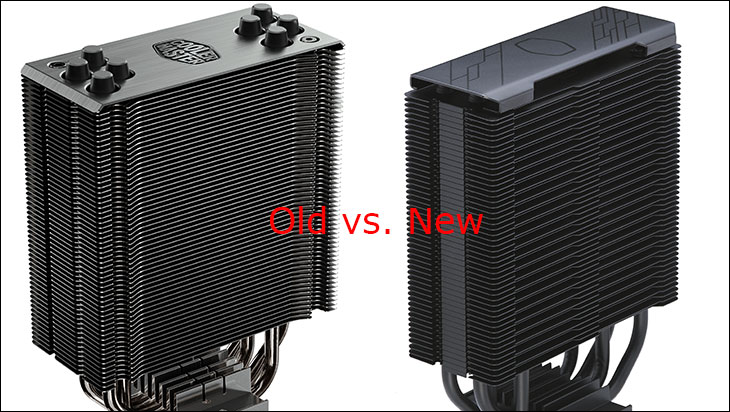
Before we move on, with its light black coating (that occasionally looked more like ‘blackened chrome’ than black) the Hyper 212 RGB Black Edition was the Rachel Dolezal of the Hyper 212 models… and was (at best) “blackish”. Some of the Chinese Clones were not even that good and either looked downright pale or use paint that is… well… fragile. We have actually used clones that after six months the vibrations from the fan had actually rubbed said paint off where it came in contact with the fan. On others, one could literally rub it off with just a tiny bit of pressure and a fingernail. Right. Out. Of. The. Box. The new Halo Black on the other hand is a legit black cooling solution. No ish. No kinda-sorta. No ‘depending on lighting’. This paint is a deep, rich black that just plain works with the majority of custom builds. More importantly, the paint is downright robust and reminds us strongly of some of the ‘paint’ that our various rifles come clad in (and better than what SIG USA use on some of their 1911s).
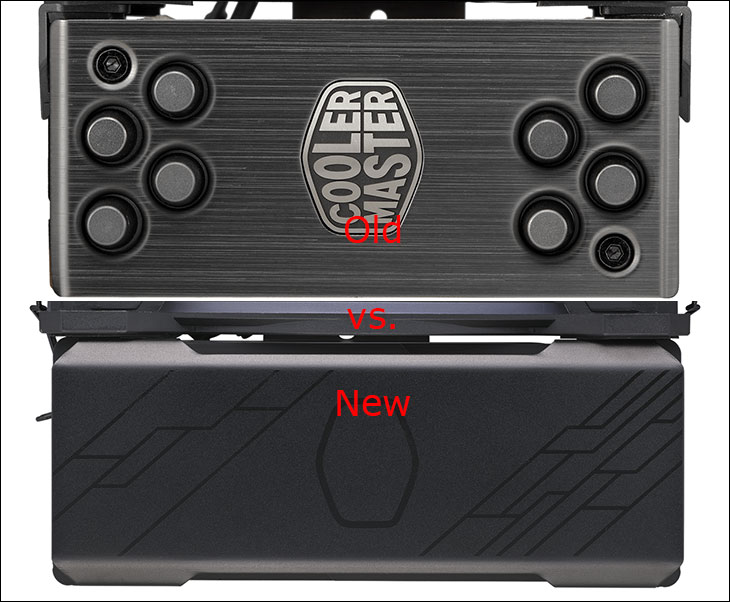
The last improvement Cooler Master has baked in is the topper that the Halo Black uses. In previous generation(s) Hyper’s did not come with a ‘topper’ that hid the top of the heatpipes. Some did not even come with a topper at all. For their price, this quirk and the associated negative impact on the final build’s aesthetics was tolerable. Then the ‘premium’ clones came along and included a free topper. Some legit look great with faux carbon fiber (and seriously work well with MSI and their carbon fiber motif boards)… and they made a great argument for both saving a few bucks and getting a better looking end result. The last gen RGB Black edition included a topper. Yes, it dramatically improved things. Yes, it was made from aluminum and not plastic (like most clones that include a topper). Sadly, it was not enough… and the best of the clones still looked better. Cheaper and better is hard to beat in this corner of the marketplace… as money talks louder than the morality of IP infringement.

The new Halo Black changes that equation nicely. Instead of a half-baked topper (that still showed off the tops of the heatpipes) the new aluminum topper actually looks like it belongs on a premium edition cooler. It is elegant. It is sophisticated… and it will work in a lot more builds than faux carbon fiber will. When you add all these improvements up, the Halo Black the best looking 212 available today. It simply looks and acts like a premium cooler… as it should as it is priced like one. Are the overall improvements enough to warrant the increase in asking price? We think so but in the following pages we will give you the hard data so you can make your own final decision.
